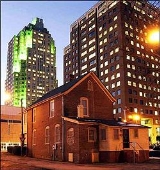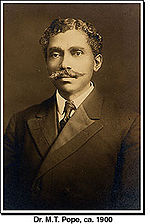
Pope House Museum
Encyclopedia
The Pope House Museum, built in 1901, is a restored home once owned by Dr. M.T. Pope, a prominent African-American citizen of Raleigh, North Carolina
. The Pope House is listed on the National Register of Historic Places
, and is also an official project of the Save America’s Treasures Program.
Since the early 19th century, the area where the Pope House is located has gone through many transformations. When the original governor’s mansion
was built at the end of Fayetteville Street
on the site of the present Memorial Auditorium
, it was thought that fashionable residences would be built nearby. Although a few substantial homes were constructed by white families, when Reverend Henry Tupper moved Shaw University
to the neighborhood in 1870, many new African-American residents drawn to Raleigh after the Civil War
settled in the area. Pope attended Leonard Medical Center
at Shaw University before beginning his medical practice.
 Black professionals began to build homes in the area known as the Third Ward, which included the 500 block of South Wilmington Street. In 1901, Pope decided to build his house in this area. Pope’s neighbors included other prominent African Americans, including another doctor and a pharmacist
Black professionals began to build homes in the area known as the Third Ward, which included the 500 block of South Wilmington Street. In 1901, Pope decided to build his house in this area. Pope’s neighbors included other prominent African Americans, including another doctor and a pharmacist
. His home was located near his office on East Hargett Street, which at the time was the heart of the black business district.
Pope installed the latest technology in his home, including combination gas and electric fixtures, a kitchen with running water, a full bathroom on the second floor, coal burning heating stoves, and a telephone. He also installed a call bell system, with buttons in each room and an annunciator in the back hall. Pope began to see patients in the house during the 1920s and 1930s, when his health began to fail. The small area at the rear of the back hall, adjacent to the kitchen, was configured to include a small hand sink and built-in cabinet for instruments
.
After Pope married Delia Haywood Phillips in 1907, the couple added a garage and wired the home for electricity. In the 1920s, the original front porch was removed, and the current sleeping porch constructed on brick piers. In the 1940s, the northern half of the first floor space below the porch was enclosed with brick, as it remains today. They eventually had two children, Eveyln and Ruth. After the deaths of their parents, Evelyn and Ruth maintained the family home, though they lived in Durham
and Chapel Hill
respectively.
Although the Pope House remains in the neighborhood, the area around it has dramatically changed. Older homes and businesses were replaced with office buildings, parking lots and newer homes. The most evident change was the construction of the Raleigh Convention Center directly across the street from the house. Today, the house is in the shadows of skyscrapers that were built in the 1980s and 1990s.
The Pope House was officially listed on the National Register of Historic Places on November 22, 1999. The following month the trustees of the Pope Charitable Foundation decided to begin the process of turning the house into a museum. One month later, The Pope House Museum Foundation was incorporated as a non-profit organization
. The extensive family papers were sorted and catalogued, and donated to the Southern Historical Collection
at the University of North Carolina at Chapel Hill
.
Raleigh, North Carolina
Raleigh is the capital and the second largest city in the state of North Carolina as well as the seat of Wake County. Raleigh is known as the "City of Oaks" for its many oak trees. According to the U.S. Census Bureau, the city's 2010 population was 403,892, over an area of , making Raleigh...
. The Pope House is listed on the National Register of Historic Places
National Register of Historic Places
The National Register of Historic Places is the United States government's official list of districts, sites, buildings, structures, and objects deemed worthy of preservation...
, and is also an official project of the Save America’s Treasures Program.
Since the early 19th century, the area where the Pope House is located has gone through many transformations. When the original governor’s mansion
North Carolina Executive Mansion
The North Carolina Executive Mansion is the official residence of the Governor of North Carolina and his or her family. Building began in the year 1883 and it was designed by noted architects Samuel Sloan and A.G. Bauer. The first occupants, Governor Daniel G. Fowle and his family, moved into the...
was built at the end of Fayetteville Street
Fayetteville Street (Raleigh)
Fayetteville Street is a major street in downtown Raleigh, North Carolina, USA. It is a north-south thoroughfare that connects the State Capitol to the Raleigh Convention Center and the Progress Energy Center for the Performing Arts...
on the site of the present Memorial Auditorium
Progress Energy Center for the Performing Arts
The Progress Energy Center for the Performing Arts is the main venue for the performing arts in Raleigh, North Carolina.The naming rights to the center currently are held by Progress Energy, which purchased them from the city in 2005 for a 20-year term at the cost of $7.5 million...
, it was thought that fashionable residences would be built nearby. Although a few substantial homes were constructed by white families, when Reverend Henry Tupper moved Shaw University
Shaw University
Shaw University, founded as Raleigh Institute, is a private liberal arts institution and historically black university in Raleigh, North Carolina, United States. Founded in 1865, it is the oldest HBCU in the Southern United States....
to the neighborhood in 1870, many new African-American residents drawn to Raleigh after the Civil War
American Civil War
The American Civil War was a civil war fought in the United States of America. In response to the election of Abraham Lincoln as President of the United States, 11 southern slave states declared their secession from the United States and formed the Confederate States of America ; the other 25...
settled in the area. Pope attended Leonard Medical Center
Leonard Hall (Shaw University)
Leonard Hall is a historic educational building located on the campus of Shaw University in Raleigh, North Carolina. Built in 1881 and originally named Leonard Medical Center , Leonard Hall was established when medical schools were professionalizing...
at Shaw University before beginning his medical practice.

Pharmacist
Pharmacists are allied health professionals who practice in pharmacy, the field of health sciences focusing on safe and effective medication use...
. His home was located near his office on East Hargett Street, which at the time was the heart of the black business district.
Pope installed the latest technology in his home, including combination gas and electric fixtures, a kitchen with running water, a full bathroom on the second floor, coal burning heating stoves, and a telephone. He also installed a call bell system, with buttons in each room and an annunciator in the back hall. Pope began to see patients in the house during the 1920s and 1930s, when his health began to fail. The small area at the rear of the back hall, adjacent to the kitchen, was configured to include a small hand sink and built-in cabinet for instruments
Medical device
A medical device is a product which is used for medical purposes in patients, in diagnosis, therapy or surgery . Whereas medicinal products achieve their principal action by pharmacological, metabolic or immunological means. Medical devices act by other means like physical, mechanical, thermal,...
.
After Pope married Delia Haywood Phillips in 1907, the couple added a garage and wired the home for electricity. In the 1920s, the original front porch was removed, and the current sleeping porch constructed on brick piers. In the 1940s, the northern half of the first floor space below the porch was enclosed with brick, as it remains today. They eventually had two children, Eveyln and Ruth. After the deaths of their parents, Evelyn and Ruth maintained the family home, though they lived in Durham
Durham, North Carolina
Durham is a city in the U.S. state of North Carolina. It is the county seat of Durham County and also extends into Wake County. It is the fifth-largest city in the state, and the 85th-largest in the United States by population, with 228,330 residents as of the 2010 United States census...
and Chapel Hill
Chapel Hill, North Carolina
Chapel Hill is a town in Orange County, North Carolina, United States and the home of the University of North Carolina at Chapel Hill and UNC Health Care...
respectively.
Although the Pope House remains in the neighborhood, the area around it has dramatically changed. Older homes and businesses were replaced with office buildings, parking lots and newer homes. The most evident change was the construction of the Raleigh Convention Center directly across the street from the house. Today, the house is in the shadows of skyscrapers that were built in the 1980s and 1990s.
The Pope House was officially listed on the National Register of Historic Places on November 22, 1999. The following month the trustees of the Pope Charitable Foundation decided to begin the process of turning the house into a museum. One month later, The Pope House Museum Foundation was incorporated as a non-profit organization
Non-profit organization
Nonprofit organization is neither a legal nor technical definition but generally refers to an organization that uses surplus revenues to achieve its goals, rather than distributing them as profit or dividends...
. The extensive family papers were sorted and catalogued, and donated to the Southern Historical Collection
Southern Historical Collection
The Southern Historical Collection is a repository of distinct archival collections at the University of North Carolina at Chapel Hill which document the culture and history of the American South...
at the University of North Carolina at Chapel Hill
University of North Carolina at Chapel Hill
The University of North Carolina at Chapel Hill is a public research university located in Chapel Hill, North Carolina, United States...
.

